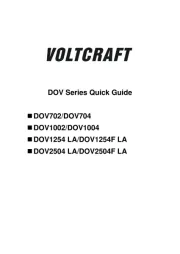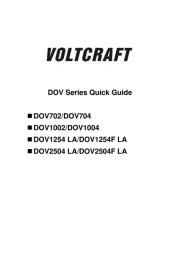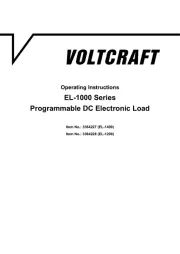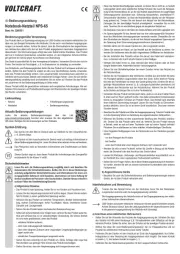Voltcraft SLC-100 Handleiding
Voltcraft
Niet gecategoriseerd
SLC-100
Bekijk gratis de handleiding van Voltcraft SLC-100 (4 pagina’s), behorend tot de categorie Niet gecategoriseerd. Deze gids werd als nuttig beoordeeld door 303 mensen en kreeg gemiddeld 4.5 sterren uit 152 reviews. Heb je een vraag over Voltcraft SLC-100 of wil je andere gebruikers van dit product iets vragen? Stel een vraag
Pagina 1/4

쮕B E D I E N U N G S A N L E I T U N G °
Version 06/09
Schallpegelkalibrator SLC-100
Best.-Nr.10 12 91
Bestimmungsgemäße Verwendung
Der Schallpegelkalibrator dient zum Abgleich und zur Überprüfung der Genauigkeit von
Schallpegelmessgeräten. Der Kalibrator erzeugt ein definiertes Schallsignal mit einem
umschaltbaren Schallpegel von wahlweise 94 dB (Dezibel) oder 114 dB. Die Sinus-
Tonfrequenz beträgt 1 kHz.
Es können Mikrofone mit einem Durchmesser von 12,7 mm (0,5 Zoll) in die Kalibrierkammer
gesteckt werden.
Die spezifizierten Genauigkeiten sind bei einem atmosphärischen Druck von 1013 hPa, einer
Umgebungstemperatur von 23°C und einer Luftfeuchtigkeit von 65%rF gegeben.
Das Gerät erfüllt die Genauigkeit nach Richtlinie IEC 60942-2003 Class 2.
Die Spannungsversorgung erfolgt durch eine 9 V-Blockbatterie.
Ein Betrieb in explosionsgefährdeten Bereichen bzw. die Anwendung bei Menschen und Tieren
ist nicht zulässig.
Eine andere Verwendung als zuvor beschrieben, kann zur Beschädigung dieses Produktes und
zu Verletzungen führen. Das gesamte Produkt darf nicht geändert bzw. umgebaut werden!
Die Sicherheitshinweise sind unbedingt zu beachten!
Sicherheitshinweise
Lesen Sie bitte vor Inbetriebnahme die komplette Anleitung durch, sie
enthält wichtige Hinweise zum korrekten Betrieb.
Bei Schäden, die durch Nichtbeachten dieser Bedienungsanleitung ver-
ursacht werden, erlischt die Gewährleistung/Garantie. Für Folgeschäden
übernehmen wir keine Haftung!
Bei Sach- oder Personenschäden, die durch unsachgemäße Handhabung
oder Nichtbeachten der Sicherheitshinweise verursacht werden, über-
nehmen wir keine Haftung! In solchen Fällen erlischt die Gewährleistung/
Garantie.
Dieses Gerät hat das Werk in sicherheitstechnisch einwandfreien Zustand verlassen.
Um diesen Zustand zu erhalten und einen gefahrlosen Betrieb sicherzustellen, muss der
Anwender die Sicherheitshinweise und Warnvermerke beachten, die in dieser
Bedienungsanleitung enthalten sind. Folgende Symbole gilt es zu beachten:
Ein in einem Dreieck befindliches Ausrufezeichen weist auf wichtige Hinweise in
dieser Bedienungsanleitung hin, die unbedingt zu beachten sind.
Dieses Gerät ist CE-konform und erfüllt die erforderlichen europäischen
Richtlinien.
☞Das „Hand“-Symbol ist zu finden, wenn Ihnen besondere Tipps und Hinweise zur
Bedienung gegeben werden sollen.
Aus Sicherheits- und Zulassungsgründen (CE) ist das eigenmächtige Umbauen und/oder
Verändern des Gerätes nicht gestattet.
Legen Sie das Gerät bei Nichtgebrauch immer in der Tasche ab. Empfindliche Oberflächen
(Möbelpolituren etc.) könnten mit dem Gehäuse chemisch reagieren.
Vermeiden Sie eine starke mechanische Belastung bzw. Vibrationen oder Stöße.
Das Gerät gehört nicht in Kinderhände. Es ist kein Spielzeug.
Lassen Sie Verpackungsmaterial nicht achtlos liegen. Dieses könnte für Kinder zu einem
gefährlichen Spielzeug werden.
In gewerblichen Einrichtungen sind die Unfallverhütungsvorschriften des Verbandes der
gewerblichen Berufsgenossenschaften für elektrische Anlagen und Betriebsmittel zu beachten.
Wenn anzunehmen ist, dass ein gefahrloser Betrieb nicht mehr möglich ist, so ist das Gerät
außer Betrieb zu setzen und gegen unbeabsichtigten Betrieb zu sichern. Es ist anzunehmen,
dass ein gefahrloser Betrieb nicht mehr möglich ist, wenn:
• das Gerät sichtbare Beschädigungen aufweist,
• das Gerät nicht mehr arbeitet und
• nach längerer Lagerung unter ungünstigen Verhältnissen oder
• nach schweren Transportbeanspruchungen.
Beachten Sie auch die Sicherheitshinweise in den einzelnen Kapiteln bzw. in den Bedienungs-
anleitungen der angeschlossenen Geräte.
Nehmen Sie das Gerät niemals gleich dann in Betrieb, wenn es von einem kalten in einen
warmen Raum gebracht wird. Das dabei entstandene Kondenswasser kann unter ungünstigen
Umständen Ihr Gerät zerstören. Lassen Sie das Gerät uneingeschaltet auf Zimmertemperatur
kommen.
Lieferumfang
Schallpegelkalibrator SLC-100
9 V Blockbatterie
Tasche
Bedienungsanleitung.
Inbetriebnahme
Batterie einsetzen und wechseln
Bei Erstinbetriebnahme muss die beiliegende Batterie in das rückseitige Batteriefach einge-
setzt werden bzw. ist bei Inbetriebnahme des Schallkalibrators kein Ton hörbar, so ist ein
Batteriewechsel erforderlich.
Zum Einsetzen und Wechseln der Batterie gehen Sie wie folgt vor:
- Schalten Sie das Gerät am Schiebeschalter aus (Position „OFF“)
- Lösen Sie die Schraube am rückseitigen Batteriefach und nehmen Sie den Deckel ab.
- Setzen Sie eine neue 9 V Blockbatterie ein. Achten Sie auf die richtige Polarität.
- Schließen Sie das Batteriefach und verschrauben es wieder zuverlässig.
Kalibrierbetrieb
Prüfen Sie die Funktion des Kalibrators vor jedem Abgleich mit einem
Schallpegelmesser. Schalten Sie dazu den Kalibrator am Schiebeschalter
auf die Prüfstufe 114 dB. Ein Prüfton muss hörbar sein. Ist dies nicht der Fall,
muss ein Batteriewechsel erfolgen.
Stellen Sie den Schiebeschalter auf die gewünschte Prüfposition (94 oder 114 dB). Es sollte
der Pegel gewählt werden, welcher näher am Maximum des Messbereiches des Schallpegel-
messgerätes liegt.
Stecken Sie das Mikrofon des Schallpegelmessgerätes soweit wie möglich in die Kalibrier-
kammer an der Oberseite.
Schalten Sie Ihr Schallpegelmessgerät ein und kontrollieren Sie die Anzeige auf dem Display.
Weicht die Anzeige im Display des Schallpegelmessgerätes mehr als 0,5 dB vom
Ausgangspegel (94 oder 114 dB) des Schallpegelkalibrators ab, muss das Schallpegelmess-
gerät nachjustiert werden. Durch Umschalten des Pegelwahlschalters (94 oder 114 dB) kann
auch die Linearität des Schallpegelmessgerätes überprüft werden.
Schalten Sie nach Beendigung der Kalibrierung den Schallpegelkalibrator aus (Position „OFF“).
☞Laute Umgebungsgeräusche und Vibrationen können die Kalibration beeinflus-
sen. Führen Sie daher die Kalibration in ruhiger Umgebung durch.
Wartung und Reinigung
Das Gerät ist bis auf eine gelegentliche Reinigung und dem Batteriewechsel wartungsfrei.
Verwenden Sie zur Reinigung ein weiches, antistatisches und fusselfreies Tuch.
Entsorgung
Elektronische Altgeräte sind Wertstoffe und gehören nicht in den Hausmüll. Ist das
Gerät am Ende seiner Lebensdauer, so entsorgen Sie es nach den geltenden
gesetzlichen Bestimmungen bei den kommunalen Sammelstellen. Eine
Entsorgung über den Hausmüll ist untersagt.
Sie als Endverbraucher sind gesetzlich zur Rückgabe aller(Batterieverordnung)
gebrauchten Batterien und Akkus verpflichtet; eine Entsorgung über den
Hausmüll ist untersagt!
Ihre verbrauchten Batterien/Akkus können Sie unentgeltlich bei den Sammel-
stellen Ihrer Gemeinde, unseren Filialen oder überall dort abgeben, wo
Batterien/Akkus verkauft werden!
Sie erfüllen damit die gesetzlichen Verpflichtungen und leisten Ihren Beitrag
zum Umweltschutz!
Technische Daten
Ausgangspegel 114 dB/94 dB
unter Referenzbedingungen
Ausgangsfrequenz 1 kHz ± 4 %, Sinus
Referenzbedingungen:
- Temperatur 23°C
- Relative Luftfeuchtigkeit 65 %rF
- Atmosphärischer Druck 1013 hPa
Temperatur-Koeffizient ± 0,02 dB/°C
Genauigkeit Ausgangspegel ± 0,5 dB (94 dB), ± 1 dB (114 dB)
unter Referenzbedingungen
Spannungsversorgung 9 V Blockbatterie Alkaline
Batterielebensdauer ca. 40 Std. (Alkaline-Batterie)
Betriebstemperatur 0 bis + 50°C
Lagerbedingungen - 20 bis + 60°C, <80 %rF
Abmessungen (L x B x H) 120 x 50 x 42 mm
Gewicht ca. 278 g
VOLTCRAFT
®
Impressum
Diese Bedienungsanleitung ist eine Publikation von Voltcraft ®
, Lindenweg 15, D-92242 Hirschau, Tel.-Nr. 0180/586 582 7 (www.voltcraft.de).
Alle Rechte einschließlich Übersetzung vorbehalten. Reproduktionen jeder Art, z.B. Fotokopie, Mikroverfilmung, oder die Erfassung in
elektronischen Datenverarbeitungsanlagen, bedürfen der schriftlichen Genehmigung des Herausgebers. Nachdruck, auch auszugsweise, verboten.
Diese Bedienungsanleitung entspricht dem technischen Stand bei Drucklegung. Änderung in Technik und Ausstattung vorbehalten.
© Copyright 2009 by Voltcraft®
쮕

O P E R A T I N G I N S T R U C T I O N S °
Version 06/09
Sound Level Calibrator SLC-100
Item-No. 10 12 91
Intended Use
The sound level calibrator is intended for adjusting and testing the accuracy of sound level
meters. The calibrator generates a defined sound signal with a switchable sound level of 94 dB
(Decibel) or 114 dB. The sine audio frequency is 1 kHz.
Microphones with a diameter of 12.7 mm (0.5 inches) can be inserted in the calibration
chamber.
The specified accuracies are obtained at an atmospheric pressure of 1013 hPa, an ambient
temperature of 23°C and an air humidity of 65%rF.
The accuracy of the device complies with the Directive IEC 60942-2003 Class 2.
The power is supplied by a 9V block battery.
Do not use in explosive areas or on persons or animals.
Any other use than described above is not permitted, it could cause damage to the product and
personal injury. No part of the product may be modified or rebuilt!
Observe the safety instructions in their entirety!
Safety Instructions
Please read all of the operating instructions before using the product for the
first time; they contain important information about the correct operation.
The warranty will be void in the event of damage caused by failure to observe
these safety instructions! We do not assume any liability for any conse-
quential damage!
We do not assume any liability for material and personal damage caused by
improper use or non-compliance with the safety instructions! The warranty
will be void in such cases.
This device left the manufacture’s factory in a safe and perfect condition.
We kindly request the user to observe the safety instructions and warnings contained in the
enclosed operating instructions so this condition is maintained and to ensure safe operation.
Please pay attention to the following symbols:
A triangle containing an exclamation mark indicates important information in these
operating instructions which is to be observed without fail.
This product has been CE tested and complies with the required European
guidelines.
☞The „hand“ symbol is used to indicate where specific hints and information on han-
dling are given.
The unauthorized conversion and/or modification of the product is inadmissible for reasons of
safety and approval (CE).
Keep the device in the case when it is not in use. Sensitive surfaces (furniture polish, etc.) might
cause chemical reactions with the housing.
Avoid strong mechanical stress, vibrations or blows.
Keep the unit out of the reach of children. It is not a toy.
Do not leave packaging material unattended. It may become dangerous playing material for
children.
On industrial sites, the accident prevention regulations of the association of the industrial work-
ers’ society for electrical equipment and utilities must be followed.
If you have a reason to believe that the device can no longer be operated safely, disconnect it
immediately and secure it against being operated unintentionally. It can be assumed that safe
operation is no longer possible if:
• the device is visibly damaged,
• the device no longer works and
• the unit was stored under unfavourable conditions for a long period of time or
• it has been subjected to considerable stress in transit.
You should also heed the additional safety instructions in each chapter of the operating instruc-
tions for the connected devices.
Never switch the device on immediately after it has been taken from a cold into a warm envi-
ronment. Condensation that forms might destroy your device. Allow the device to reach room
temperature before switching it on.
Included in the package
Sound level calibrator SLC-100
9 V block battery
Carrying case
Operating manual.
Getting started
Inserting/replacing the battery
To start the device, the battery enclosed must be inserted into the battery compartment on the
rear, or if there is no sound during the start up of the sound calibrator, the battery must be
replaced.
To insert/replace the battery, proceed as follows:
- Turn the device off using the sliding switch (position „OFF“)
- Unscrew the battery compartment lid on the back and remove the cover.
- Insert a new 9 V block battery. Pay attention to the correct polarity.
- Close the battery compartment and screw the cover down correctly.
Calibration
Check the correct functioning of the calibrator, before each adjustment of a
sound level meter. To do this, switch the calibrator to the 114 dB testing lev-
el using the sliding switch. A test tone must be audible. If this is not the
case, the battery must be replaced.
Set the sliding switch to the appropriate test position (94 or 114 dB). You should select the lev-
el which is closest to the maximum of the measuring range of the sound level meter.
Place the microphone of the sound level meter as far as possible into the calibration chamber
on the top.
Switch on your sound level meter and check the indication on the display. If the indication on
the display of the sound level meter varies by more than 0.5 dB from the output level (94 or 114
dB) of the sound level calibrator, the sound level meter has to be readjusted. By reversing the
level selector switch (94 or 114dB) it is possible to check the linearity of the sound level meter.
Switch off the sound level calibrator after finishing the calibration (position „OFF“).
☞Loud ambient noises and vibrations may affect the calibration. Therefore, perform
the calibration in a quiet environment.
Maintenance and Cleaning
Apart from occasional cleaning and battery replacements, the device requires no servicing. Use
a soft, antistatic and lint-free cloth for cleaning.
Disposal
Electronic products are raw material and do not belong in the household waste.
When the device has reached the end of its service life, please dispose of it,
according to the current statutory requirements, at your local collecting site.
Disposal in the domestic waste is not permitted!
As a consumer you are required to responsibly dispose of all(Battery Ordinance)
used batteries and rechargeable batteries; do not dispose of used batteries in
the household waste!
You can return used (rechargeable) batteries free of charge at the official collection
points in your municipality, our stores, or where ever (rechargeable) batteries are
sold!
You thus fulfil the legal requirements and make your contribution to protecting the
environment!
Technical Data
Output level 114 dB/94 dB
under reference conditions
Output frequency 1 kHz ± 4 %, sine
Reference conditions:
- Temperature 23°C
- Relative air humidity 65 %rF
- Atmospheric pressure 1013 hPa
Temperature coefficient ± 0.02 dB/°C
Accuracy output level ± 0.5 dB (94 dB), ± 1 dB (114 dB)
under reference conditions
Voltage Supply 9 V block alkaline battery
Battery life approx. 40 hrs (alkaline battery)
Operating temperature 0 to + 50 °C
Storage conditions - 20 to + 60°C, <80 %rF
Dimensions (LxWxH) 120 x 50 x 42 mm
Weight approx. 278 g
Impressum /legal notice in our operating instructions
These operating instructions are a publication by Voltcraft®, Lindenweg 15, D-92242 Hirschau/Germany, Phone +49 180/586 582 7 (www.voltcraft.de).
All rights including translation reserved. Reproduction by any method, e.g. photocopy, microfilming, or the capture in electronic data processing
systems require the prior written approval by the editor. Reprinting, also in part, is prohibited.
These operating instructions represent the technical status at the time of printing. Changes in technology and equipment reserved.
© Copyright 2009 by Voltcraft®
VOLTCRAFT
®

M O D E D ’ E M P L O I °
Version 06/09
Étalonneur du niveau acoustique SLC-100
N° de commande 10 12 91
Utilisation conforme
L’étalonneur de niveau acoustique sert à l’équilibrage et à la vérification de la précision d’ap-
pareils de mesure du niveau acoustique. L’étalonneur génère un signal sonore défini d’un
niveau acoustique commutable de 94 dB (décibels) ou de 114 dB au choix. La fréquence
acoustique sinusoïdale est de 1 kHz.
La chambre d’étalonnage permet la mise en place de microphones d’un diamètre de 12,7 mm
(0,5 pouces).
Les précisions spécifiées valent pour une pression atmosphérique de 1013 hPa, une tempéra-
ture ambiante de 23°C et une humidité relative de l’air de 65 % rF.
L’appareil est conforme aux prescriptions de précision de la directive CEI 60942-2003
Classe 2.
L’alimentation électrique est assurée par une pile bloc de 9 V.
L’utilisation de l’appareil dans des zones présentant un risque d’explosion ainsi que l’utilisation
sur l’homme ou les animaux n’est pas autorisée.
Toute utilisation autre que celle décrite précédemment peut provoquer l’endommagement de
ce produit ainsi que des blessures. L’ensemble de l’appareil ne doit être ni transformé, ni
modifié !
Il est impératif de respecter les consignes de sécurité !
Consignes de sécurité
Lisez intégralement les instructions d’utilisation avant la mise en service de
l’appareil, elles contiennent des consignes importantes pour son bon fonc-
tionnement.
Tout dommage résultant d’un non-respect du présent mode d’emploi entraî-
ne l’annulation de la garantie. Nous déclinons toute responsabilité pour les
dommages causés !
Nous déclinons toute responsabilité pour d’éventuels dommages matériels
ou corporels dus à un maniement incorrect ou à la non-observation des pré-
cautions d’emploi ! Dans ces cas-là, la garantie est annulée.
Ce produit est sorti de l’usine de fabrication dans un état irréprochable du point de vue de la
sécurité technique.
Pour maintenir le produit dans cet état et pour assurer un fonctionnement sans risques, l’utili-
sateur est tenu d’observer les consignes de sécurité et les avertissements figurant dans le pré-
sent mode d’emploi. Respectez les pictogrammes suivants :
Dans ce mode d’emploi, un point d’exclamation placé dans un triangle signale des
informations importantes à respecter impérativement.
Cet appareil est homologué CE et répond aux directives européennes requises.
☞Le symbole de la „main“ précède des recommandations et indications d’utilisation
particulières.
Pour des raisons de sécurité et d’homologation (CE), les transformations et / ou modifications
de l’appareil réalisées à titre individuel, sont interdites.
Toujours placer l’appareil dans la sacoche quand il n’est pas utilisé. Des surfaces sensibles
(encaustique, etc.) peuvent avoir des réactions chimiques au contact avec le boîtier.
Éviter de fortes contraintes mécaniques ou des vibrations et chocs.
Tenir l’appareil hors de portée des enfants. Ce n’est pas un jouet.
Ne pas laisser le matériel d’emballage sans surveillance. Il pourrait devenir un jouet dangereux
pour les enfants.
Sur les sites industriels, il convient d’observer les mesures de prévention d’accidents relatives
aux installations et aux matériels électriques des associations préventives des accidents de
travail.
Lorsqu’un fonctionnement sans risques de l’appareil n’est plus assuré, mettez-le hors service
et veillez à ce qu’il ne puisse plus être remis en service involontairement. Le fonctionnement
sans risque n’est plus assuré lorsque :
• l’appareil présente des dommages visibles,
• l’appareil ne fonctionne plus et
• l’appareil a été stocké durant une période prolongée dans des conditions défavorables,
• l’appareil a été transporté dans des conditions défavorables.
Tenez également compte des consignes de sécurité supplémentaires de chaque chapitre de
ce mode d’emploi ainsi que des modes d’emploi des appareils connectés.
Ne mettez jamais immédiatement en marche le produit lorsqu’il vient d’être transporté d’une
pièce froide à une pièce chaude. L’eau de condensation qui en résulte peut, dans des condi-
tions défavorables, détruire l’appareil. Attendez que l’appareil non branché ait atteint la tempé-
rature ambiante.
Étendue de la fourniture
Étalonneur du niveau acoustique SLC-100
Pile bloc de 9 V
Sacoche
Instructions d’utilisation
Mise en service
Insérer ou remplacer la pile
Pour la première mise en service, insérer la pile fournie dans le compartiment à piles au dos,
si l’étalonneur n’émet aucun son lors de la mise en service, la pile doit être remplacée.
Pour insérer ou remplacer les piles, procéder comme suit :
- Éteindre l’appareil avec l’interrupteur coulissant (position „OFF“)
- Desserrer la vis du compartiment à piles au dos et retirer le couvercle.
- Insérer une pile bloc 9 V neuve. Veiller à la polarité correcte.
- Fermer le compartiment à piles et revisser correctement.
Étalonnage
Vérifier le fonctionnement de l’étalonneur avant chaque équilibrage à l’aide
d’un appareil de mesure du niveau acoustique. Pour cela, régler l’étalonneur
à l’aide de l’interrupteur coulissant sur le niveau d’essai 114 dB. Le son d’es-
sai doit être audible. Si ce n’est pas le cas, il convient de remplacer la pile.
Placer l’interrupteur coulissant sur la position d’essai souhaitée (94 ou 114 dB). Il convient de
choisir le niveau le plus près du maximum de la plage de mesure de l’appareil de mesure du
niveau acoustique.
Introduire le microphone de l’appareil de mesure du niveau acoustique aussi loin que possible
dans la chambre d’étalonnage sur le dessus.
Mettre l’appareil de mesure du niveau acoustique en marche et contrôler l’affichage sur l’écran.
Si l’affichage à l’écran de l’appareil de mesure du niveau acoustique diffère de plus de 0,5 dB
du niveau acoustique de sortie (94 ou 114 dB) de l’étalonneur du niveau acoustique, l’appareil
de mesure doit être réajusté. La commutation du sélecteur de niveau (94 ou 114 dB) permet
également de vérifier la linéarité de l’appareil de mesure du niveau acoustique.
Après l’étalonnage, éteindre l’étalonneur du niveau acoustique (position „OFF“).
☞De forts bruits ambiants et des vibrations risquent d’influencer l’étalonnage. Pour
cela, effectuer l’étalonnage dans un endroit silencieux.
Maintenance et nettoyage
À part un nettoyage occasionnel et un remplacement de la pile, l’appareil ne nécessite aucun
entretien. Utilisez pour le nettoyage un chiffon doux, antistatique qui ne peluche pas.
Élimination
Les appareils électroniques sont des matériaux recyclables et ne doivent pas être
éliminés avec les ordures ménagères ! Si l’appareil arrive au terme de sa durée de
vie, il conviendra de l’éliminer conformément aux prescriptions légales en vigueur
auprès des centres de récupération de votre commune. Il est interdit de le jeter
dans la poubelle ordinaire.
Le consommateur final est légalement tenu (ordonnance relative à l’élimination
des piles usagées) Il estde rapporter toutes les piles et tous les accus usagés.
interdit de les jeter aux ordures ménagères !
Vous pouvez rapporter gratuitement vos piles et accumulateurs usagés aux cen-
tres de récupération de votre commune, à nos succursales ou à tous les points de
vente de piles et d’accumulateurs !
Vous respectez ainsi les obligations légales et contribuez à la protection de
l’environnement !
Caractéristiques techniques
Niveau de sortie 114 dB/94 dB
dans conditions de référence
Fréquence de sortie 1 kHz ± 4 %, sinusoïdale
Conditions de référence :
- Température 23°C
- Humidité relative de l’air 65 %rF
- Pression atmosphérique 1013 hPa
Coefficient de température ± 0,02 dB/°C
Précision niveau de sortie ± 0,5 dB (94 dB), ± 1 dB (114 dB)
dans les conditions de référence
Alimentation électrique Pile bloc alcaline de 9 V
Durée de vie des piles env. 40 h (pile alcaline)
Température de service 0 à + 50°C
Conditions de stockage - 20 à + 60°C, <80 %rF
Dimensions (L x l x h) 120 x 50 x 42 mm
Poids env. 278 g
Informations /légales dans nos modes d'emploi
Ce mode d'emploi est une publication de la société Voltcraft ®, Lindenweg 15, D-92242 Hirschau/Allemagne, Tél. +49 180/586 582 7
(www.voltcraft.de).
Tous droits réservés, y compris de traduction. Toute reproduction, quelle qu'elle soit (p. ex. photocopie, microfilm, saisie dans des installations de
traitement de données) nécessite une autorisation écrite de l'éditeur. Il est interdit de le réimprimer, même par extraits.
Ce mode d'emploi correspond au niveau technique du moment de la mise sous presse. Sous réserve de modifications techniques et de l'équipement.
© Copyright 2009 by Voltcraft®
VOLTCRAFT
®
Product specificaties
| Merk: | Voltcraft |
| Categorie: | Niet gecategoriseerd |
| Model: | SLC-100 |
Heb je hulp nodig?
Als je hulp nodig hebt met Voltcraft SLC-100 stel dan hieronder een vraag en andere gebruikers zullen je antwoorden
Handleiding Niet gecategoriseerd Voltcraft

8 Juli 2025

7 Juli 2025

6 Juli 2025

2 Mei 2025

30 December 2025

30 December 2025

30 December 2025

30 December 2025

30 December 2025

30 December 2025
Handleiding Niet gecategoriseerd
- Beverage-Air
- Beafon
- Fakir
- QuickCool
- Native Trails
- Escort
- Peavey
- Globe
- Transparent
- Gardol
- Kali Audio
- Lumag
- WHALE
- CLIMAQUA
- Sonorous
Nieuwste handleidingen voor Niet gecategoriseerd

17 September 2025

17 September 2025

17 September 2025

17 September 2025

17 September 2025

17 September 2025

17 September 2025

17 September 2025

17 September 2025

17 September 2025